Source model Closed source | Working state Historic, not supported OS family Macintosh | |
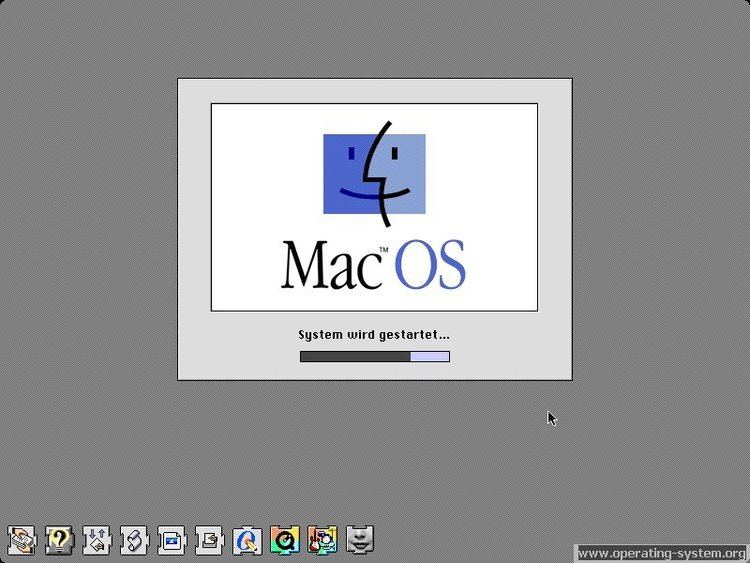 | ||
Latest release 7.6.1 / April 7, 1997; 19 years ago Initial release May 13, 1991; 25 years ago | ||
A tour of macintosh system 7
System 7 (codenamed "Big Bang" and sometimes retrospectively called Mac OS 7) is a single-user graphical user interface-based operating system for Macintosh computers and was part of the classic Mac OS line of operating systems. It was introduced on May 13, 1991, by Apple Computer. It succeeded System 6, and was the main Macintosh operating system until it was succeeded by Mac OS 8 in 1997. Features added with the System 7 release included virtual memory, personal file sharing, QuickTime, QuickDraw 3D, and an improved user interface.
Contents
- A tour of macintosh system 7
- Development
- Pink and Blue
- Software
- Transition to PowerPC
- PC compatibility
- Miscellaneous
- Version history
- Mac OS 76
- Availability
- References

"System 7" is often used generically to refer to all 7.x versions. With the release of version 7.6 in 1997, Apple officially renamed the operating system "Mac OS", a name which had first appeared on System 7.5.1's boot screen. System 7 was developed for Macs that used the Motorola 680x0 line of processors, but was ported to the PowerPC after Apple adopted the new processor.
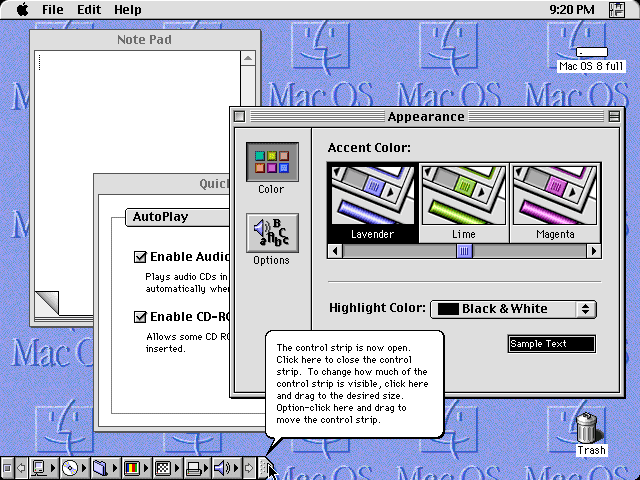
Development
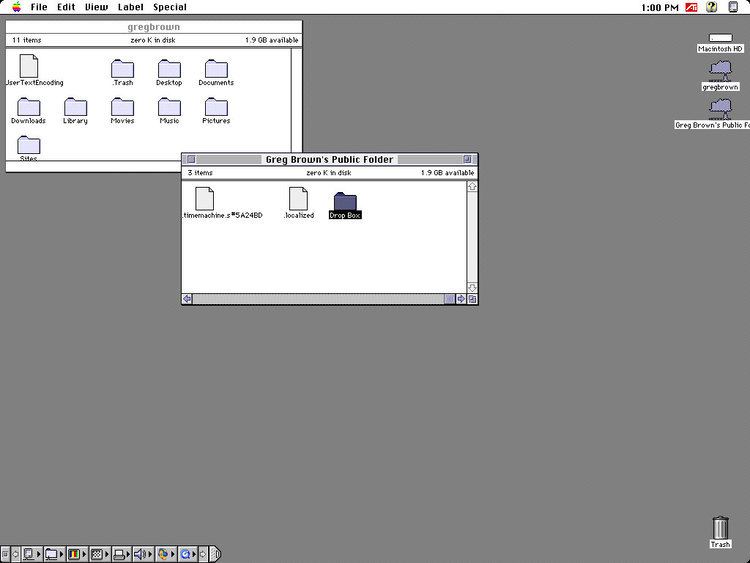
The development of the Macintosh "Systems" up to System 6 followed a fairly smooth progression with the addition of new features and relatively small changes and upgrades over time. Major additions were fairly limited, notably adding Color QuickDraw and MultiFinder in System 6. Some perspective on the scope of the changes can be seen by examining the official system documentation, Inside Macintosh. This initially shipped in three volumes, adding another to describe the changes introduced with the Mac Plus, and another for the Mac II and Mac SE.
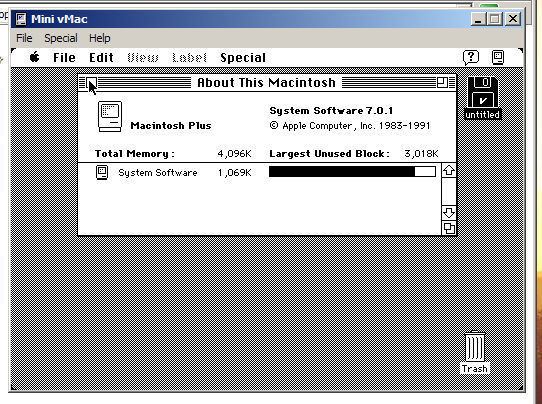
These limited changes meant that the original Mac system remained largely as it was when initially introduced. That is, the machine was geared towards a single user and task running on a floppy disk based machine of extremely limited RAM. However, many of the assumptions of this model were no longer appropriate. Most notable among these was the single-tasking model, the replacement of which had first been examined in 1986's "Switcher" and then replaced outright with MultiFinder in System 5. Running MultiFinder normally required larger amount of RAM and a hard drive, but these were becoming common by the late 1980s.
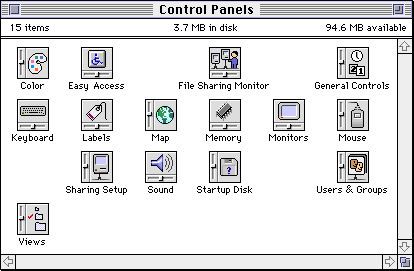
While additions had been relatively limited, so had fixes to some of the underlying oddities of the system architecture. For instance, to support a limited form of multitasking, the original Mac OS supported small co-resident programs known as desk accessories which had to be installed into the Apple menu using special tools. If the system were able to support multiple tasks, this one-off solution would no longer be needed - desk accessories could simply be small programs, placed anywhere. Yet, as MultiFinder was still optional, such a step had not been taken. Numerous examples of this sort of problem could be found throughout the system.
Finally, the widespread adoption of hard drives and local area networks led to any number of new features being requested from users and developers. By the late 1980s, the list of new upgrades and suggested changes to the existing model was considerable.
Pink and Blue
In March 1988, shortly after the release of System 6, technical middle managers at Apple held an offsite meeting to plan the future course of Mac OS development. Ideas were written on index cards; features that seemed simple enough to implement in the short term (like adding color to the user interface) were written on blue cards, longer-term goals like true multitasking on pink cards, and "far out" ideas like an object-oriented file system on red cards. Development of the ideas contained on the blue and pink cards was to proceed in parallel, and at first the two projects were known simply as "blue" and "pink" (including Taligent). Apple intended to have the "blue" team (which came to call themselves the "Blue Meanies" after characters in Yellow Submarine) release an updated version of the existing Macintosh operating system in the 1990–1991 timeframe, and the "pink" team to release an entirely new OS around 1993.
As Blue was aimed at relatively "simple" upgrades, the feature list reads to some degree as a sort of "System 6, corrected". In the underlying OS, a number of formerly optional components were made mandatory:
Furthermore, a number of oddities in the original System, typically included due to limited resources, were finally changed to use basic underlying OS features:
The system also offered a wide variety of new features:
Software
System 7 was the first Apple operating system to be available on CD, although it shipped on a set of 15 floppy disks initially. Unlike earlier systems, System 7 itself did not come bundled with major software packages. Newly purchased Macintosh computers had System 7 installed and were often bundled with software such as HyperCard, At Ease and Mouse Practice. Later, the Macintosh Performa series added various software bundles including third-party software such as ClarisWorks, The New Grolier Multimedia Encyclopedia, Microsoft Bookshelf, Spectre VR and Power Pete. Since System 7 was introduced before the Internet came to popular attention, software such as MacTCP, FreePPP and Netscape were not included at first, but was later available on disk from Internet service providers and bundled with books such as Adam C. Engst's Internet Starter Kit for Macintosh. PowerPC Macintoshes included Graphing Calculator. System 7 also included AppleTalk networking and file sharing software in the form of system extensions and control panels.
The basic utilities installed by default with System 7 included TeachText (superseded by the more flexible SimpleText in later versions) for basic text editing tasks and reading readme documents. Also available on the additional "Disk Tools" floppy disk are Disk First Aid for disk repair and Apple HD SC Setup for initializing and partitioning disks.
Later versions of System 7, specifically System 7.5 and Mac OS 7.6, came with a dedicated "Utilities" folder and "Apple Extras" folder including: AppleScript, Disk Copy, QuickDraw GX Extras and QuickTime Movie Player. More optional extras and utilities could be manually installed from the System CD.
Transition to PowerPC
System 7.1.2 was the first version of the Mac OS to support Apple's new PowerPC-based computers. 68k applications which had not yet been updated to run natively on these systems were emulated transparently (without users' having to intervene) by a built-in 68k processor emulator. Fat binaries, which contained the code necessary to run natively on both PowerPC and 68k systems, became common during this time. This process was similar to the distribution of universal binaries during Apple's transition from PowerPC to Intel processors in 2006.
PC compatibility
System 7.0 through 7.1 offered a utility called Apple File Exchange, which could access the contents of FAT- and Apple II-formatted floppy disks. System 7 Pro, System 7.5 and up shipped with PC Exchange, previously a separate product, which allowed the system to mount FAT-formatted floppy disks on the desktop in the same manner as regular Macintosh disks.
OS/2 disks were read as PC DOS disks, due to fact that OS/2 used the FAT file system. At this time, Macs could also read and write UNIX file systems with the help of extra software.
System 7 allowed users to access PC networks and allowed communication via TCP/IP and other compatible networking stacks. Actual PC software compatibility, however, required third party software such as SoftPC, which allowed some MS-DOS and early Microsoft Windows programs to run, or Connectix Virtual PC, which allowed the Mac to run Windows via full PC emulation.
Other PC compatibility solutions took a more native approach by running Windows and MS-DOS by using x86 expansion cards with an x86 chip on the card. Apple offered some systems configured this way, marketed as "DOS Compatible"—a card with dedicated x86 CPU and RAM was used, while the Mac hard drive, sound subsystem, networking and input provided services to the PC. The PC could run simultaneously with the Mac, and the user could switch between the two in a fashion similar to a KVM switch. The earliest of these systems were 680x0 based systems running System 7. System 7 provided the support for accessing the PC volume from the Mac through its own PC Exchange software, and actual control of the PC hardware was accomplished by way of control panels.
Miscellaneous
At the time of its release, many users noticed that performance suffered as a result of upgrading from System 6 to System 7, though newer hardware soon made up for the speed difference. Another problem was System 7's large "memory footprint": System 6 could boot the system from a single 800k floppy disk and took up about 600 KB of RAM, whereas System 7 used well over a megabyte. It was some time before the average Mac shipped with enough RAM built in for System 7 to be truly comfortable. System 7 was the first system release that could no longer be usefully run on floppy-only systems. Although most Macintosh models sold at the time included a hard disk as standard equipment, owners of older models were required to upgrade by buying either a new Mac or external SCSI hard disk drive if they wished to run System 7.
In order to take advantage of System 7's virtual memory feature, a Macintosh equipped with a PMMU is required. The Motorola 68030 CPU has one built-in, and one can be added to the motherboard of the 68020-equipped Macintosh II. The other Macintosh model using an '020, the Macintosh LC, cannot use virtual memory. Apple introduced the '030-equipped Macintosh LC II shortly after System 7's introduction. Despite the newer processor, the LCII retained the earlier model's 16-bit bus and did not perform any faster than the LC it replaced.
Despite these setbacks, System 7.0 was adopted quite rapidly by Mac users, and quickly became one of the base requirements for new software.
The engineering group within Apple responsible for System 7 came to be known as the "Blue Meanies", named after the blue index cards on which were written the features that could be implemented in a relatively short time as part of Apple's operating system strategy. In comparison, the pink index card features were handled by the Pink group, later becoming the ill-fated Taligent project.
System 7.0 would be the last version of the Macintosh operating system that Apple made available without charge and allowed to be freely redistributed until the 2013 release of OS X Mavericks. Although System 7 could be purchased from Apple, the cost was nominal and considered to only cover duplication and media. It was perfectly legal to copy a friend's System 7 installation floppies, and it was common for Macintosh dealers to allow customers to use the store's demo machines to copy System 7 install disks for the cost of a box of floppies. CD-ROM magazines such as Nautilus included System 7 on their disks. After Mac users downloaded thousands of copies of System 7 from the online services (AOL, Compuserve and GEnie), Apple surveyed the services and based on this popularity started selling the Mac OS as a retail product with System 7.1. (System 7.5.3r2 is now available for free from Apple's web site, but was not posted until long after it had been superseded. A System 7.5.5 updater is also available for free download.)
Version history
Soon after the initial release of System 7, the 7.0.1 minor update was released in October 1991. A patch called "System 7 Tune-Up" also followed, which fixed the "disappearing files" bug in which the system would lose files and added "minimum" and "preferred" memory allotments to an application's Get Info box. In August 1992, the 7.1 update was released which incorporated these changes and introduced the Fonts folder. This replaced the often time-consuming method of dragging fonts to and from the System file, introduced in System 7.0; it also replaced the Font/DA Mover application from System 6, which could also be used with 7.0.
The first major upgrade was System 7.1.1, also known as "System 7 Pro". This release was a bundle of 7.1 with AppleScript tools, QuickTime and Apple Open Collaboration Environment (AOCE). While System 7 had some trouble running in slightly older machines due to memory footprint, System 7 Pro barely fit into any Macintosh computers at the time. It was most commonly used for its minor bug fixes rather than its new functionality.
Apple joined the AIM alliance (Apple, IBM and Motorola) shortly after the release of System 7 in 1991, and started work on PowerPC-based machines that later became the Power Macintosh family. Support for these machines resulted in System 7.1.2.
System 7.1.2 was never offered for retail sale; it shipped with the first batches of the PowerPC Macs and a 68k version shipped with a small number of Quadra 600 series systems. Later shipments shipped with System 7.5 instead.
The next major release was System 7.5, which included bug fixes from previous updates and added several new features including:
System 7.5 was codenamed "Capone", a reference to Al Capone and "Chicago", which was the code name for Microsoft's Windows 95, and, in turn, the name of the default system font used in Mac OS until version 8.
System 7.5.1 was primarily a bug fix on 7.5, but also introduced a new "Mac OS" startup screen in preparation for Mac clones.
System 7.5.2, released only for the first PCI-based Power Macs, was notable for introducing Apple's new networking architecture, Open Transport.
System 7.5.3, a major bug-fix update that also included Open Transport for other PowerPC-based machines as well as some 68k-based machines. 7.5.3 also made several improvements to the 68k emulator, and added translucent dragging support to the Drag Manager. It was also the first version of Control Strip for all Macs. This was also the first version of Mac OS to support SMP. (9500/MP)
System 7.5.3 Revision 2 included: performance enhancements; better reliability for PowerBooks using the third-party RAM Doubler program; improved reliability for PowerBook 500, 2300, and 5300 series computers with the PowerPC Upgrade Card; improved reliability when using the Startup Disk control panel; and improved reliability when copying files to 1 GB hard disks.
System 7.5.4 was pulled due to a mistake at Apple, in which some components were not included in the installer.
System 7.5.5 included significant performance improvements for virtual memory and memory management on PowerPC-based Macs, including the elimination of one type 11 error. Also included were a number of reliability improvements, such as fixes for Macs using floppy disks equipped with a DOS compatibility card, improved hard disk access for PowerPC PowerBooks and Performa 5400 through 9500 computers, fixes for Macs that included an Apple TV Tuner or Macintosh TV Remote Control, improvements to LocalTalk and networking (especially for the Performa 5400 and 6400), fixes to system startup for the faster 180 MHz Macs (which included PowerPC 604 or 604e processors), improved reliability when using sound intensive applications on Quadra or Centris computers that contained the PowerPC upgrade card, and improved stability when using multiple background applications and shared printers on a network. System 7.5.5 is also the last System 7 release that can run on 68000-based Macs such as the Macintosh Plus and 24-bit addressing only ROMs such as Macintosh IIcx. 7.6 and later required a 68030 processor and 32-bit addressing capable ROM and will automatically turn on 32-bit addressing on boot.
Mac OS 7.6
Mac OS 7.6 (codenamed "Harmony") was the last major update, released in 1997. With 7.6, the operating system was officially called "Mac OS" instead of "System". Mac OS 7.6 introduced several features that were also included in Mac OS 8, including a revamped Extensions Manager, more native PowerPC code for Power Macs, more bundled Internet tools and utilities, and a more-stable Finder with increased memory allocation. In this version, the PowerTalk feature added in 7.5 was removed due to poor application support, and support for a large number of older Macintosh models was dropped.
The minor update to Mac OS 7.6.1 finally ported the 68k exception handling routines to PowerPC, turning dreaded type 11 errors into less harmful errors (type 1, 2 or 3, usually) as crashing applications would more often terminate safely instead of crashing the operating system.
Through this period, Apple had been attempting to release a completely new "modern" operating system, named Copland. When the Copland project was abandoned in 1996, Apple announced plans to release an OS update every six months until Rhapsody (which would by 2001 evolve into what was released as Mac OS X) shipped. Two more releases were shipped, now officially branded as "Mac OS" — Mac OS 7.6 and the minor bug fix 7.6.1. Future versions were released as Mac OS 8–8.6 and Mac OS 9–9.2.
Availability
Apple created and published an "Older Software Downloads" page on their AppleCare Support website on July 17, 2001. Since then, diskette images to install System 7.0, System 7.0.1, and System 7.5.3 as well as the System 7.5.5 Update have been available as free downloads for legacy Macintosh users, as well as for those who wish to use the software through emulation of 68k and PowerPC Macintosh hardware. In addition to System 7, related downloads are also At Ease downloads and Mac OS 8 updates. All of the diskette image files are in MacBinary format and are accompanied by a descriptive readme file.
